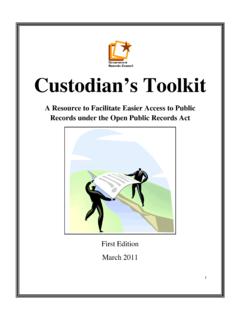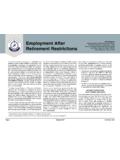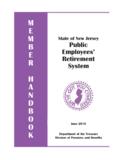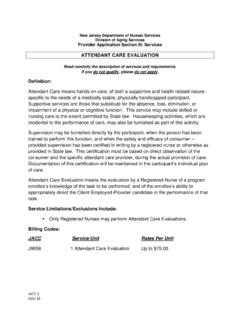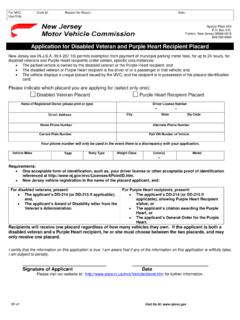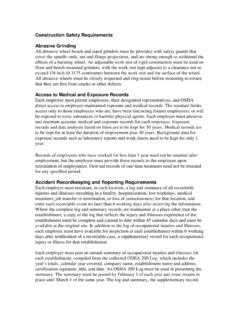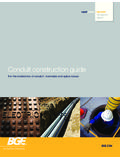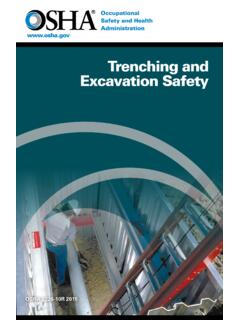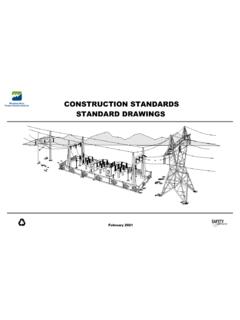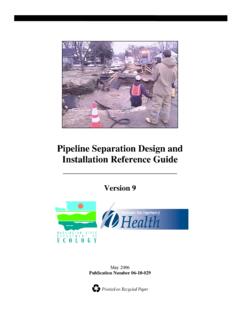Transcription of Bulletin No. 95-1B rev6 2017 - Government of New Jersey
1 Bulletin U L L E T I NState of New JerseyDepartment of Community AffairsDivision of Codes and StandardsPO Box 802 Trenton, New Jersey 08625-0802 Chris ChristieGovernorKim GuadagnoLt. GovernorCharles A. RichmanCommissionerDate: September 1995 Revised: September 2017 Subject: Removal/Abandonment Requirements for Residential Heating Oil Tanks (no limit) and Commercial Heating Oil Tanks (under 2,001 gallons)Reference: 5 , and - Responsibilities, Mechanical Subcode and One- and Two-family Dwelling SubcodePage 1 of 595-1 BThis Bulletin addresses abandonment or removal of certain heating oil tanks includingwho is responsible for inspection, and how tanks are to be abandoned or Categorized as Unregulated by NJDEP:* Residential Heating Oil Tanks (no limit); and* Commercial Heating Oil Tanks (under 2001 gallons).
2 For underground tanks: Only the Department of Environmental Protection (NJ DEP)certified individuals and firms can perform services on unregulated heating oil 7:14B defines unregulated heating oil tanks as, any one or combination oftanks, including appurtenant pipes, lines, fixtures, and other related equipment, usedto contain an accumulation of heating oil for on-site consumption in a residentialbuilding, or those tanks with a capacity of 2,000 gallons or less used to store heatingoil for on-site consumption in a nonresidential building. For the purposes of applying the DEP rules, an underground storage tank is definedas a tank the volume of which, including the volume of the appurtenant pipes, lines,fixtures and other related equipment, is 10 percent or more below the ground. Thereare separate certifications required for tank installation, tank closure and sub-surfaceevaluation (needed to oversee remediation).
3 The NJ DEP strongly recommends the removal of all out-of-service undergroundheating oil tanks even when there is no evidence the tank has leaked. Although tankabandonment is allowed, there has been an increase in previously abandoned tanksbeing removed. These tank removals are driven by insurance and mortgage companiesthat do not want the liability that these underground heating oil tanks may pose whetherthey were properly abandoned or U L L E T I N95-1 BPage 2 of 5 WHENThe Uniform construction Code (UCC) is not a retrofit code, and therefore, it doesnot deal with tanks that have been abandoned for extended periods of time. TheUCC applies when a tank is taken out of service within the scope of work of aconstruction project or when the tank has become unsafe. If a project results in anunderground tank being out of service for a period of one year, as per of the International Fire Code (IFC), the tank must be removed fromthe ground in accordance with Section of the IFC or abandoned in placein accordance with Section of the IFC.
4 If an aboveground tank is outof service for a period of one year, as per Section of the IFC, the tankshall be removed in accordance with Section of the example of a circumstance involving the removal or abandonment of an undergroundstorage tank where construction activity is taking place is a conversion from fuel oil tonatural or LP gas. In this case, code officials must ensure that the tank is properlyremoved or abandoned in connection with the conversion. The only exception to thiswould be where the owner can demonstrate a legitimate continued use of the removal or abandonment of a tank requires an application for and the issuance ofa demolition permit regardless of whether it is in connection with other related permit should contain specific details on how the tank is to be removed orabandoned in place. Prior to the issuance of the Certificate of Approval for the tankremoval or abandonment, the property owner or contractor must provide a sketchshowing the location of the removed or abandoned tank.
5 A properly filed permit forthe installation of an aboveground replacement tank should not be withheld pendingthe filing of a separate demolition permit for the removal or abandonment of anunderground tank which is not part of the contract for the installation of the new ENFORCESR emoval and abandonment procedures for underground storage tanks are containedin the IFC, Section , fuel oil storage systems, as referenced by theInternational Mechanical Code (Section ) and the International ResidentialCode (Section ). Per 5 , plan review and inspection arethe responsibility of the fire subcode TO ABANDONT here are provisions in the International Fire Code, Section , theAmerican Petroleum Institute (API) Bulletin 1604, and National Fire ProtectionAssociation (NFPA) 30 Annex C relating to the abandonment of underground storagetanks. These documents, in accordance with 5 , are acceptedengineering U L L E T I N95-1 BPage 3 of 5 Either removal or abandonment is acceptable and the procedures listed below aretypical of accepted methods.
6 For all of the methods listed, inspectors must ensurethat fill and vent pipes for aboveground (particularly tanks in basements) or undergroundtanks are removed when the tank is removed or abandoned. Several accidents haveoccurred where fuel oil deliveries have been made where a fill pipe was left in placeafter the tank was removed. For example, fuel oil has been pumped into a basementor the ground, resulting in expensive following are examples of some of the acceptable methods of tank removal/abandonment:Example A Aboveground Tank Removal Cleaned On-Site1. Remove oil from Cut hole in tank of adequate size to permit Squeegee Remove all Wipe inside of tank Remove tank (and fill pipes and vent pipes, if separate) and dispose atproper facility (Most scrap metal yards will accept cleaned storagetanks).7. Inspect site where tank was removed for any oil spillage. Any oilspillage should be cleaned and disposed of B Aboveground Tank Removal Cut and Cleaned Off-Site1.
7 Remove oil from Remove tank from Inspect site where tank was removed for any oil spillage. Any oilspillage should be cleaned and disposed of C underground Tank Removal1. Remove oil from tank and Excavate to the top of the tank. It is recommended that asphalt,concrete and piping be removed and separated from the excavatedbackfill and soil to minimize the amount of material that may needspecial Cut hole in tank of adequate size to permit Squeegee Remove all Wipe inside of tank Excavate around the tank to uncover it for Remove tank (and fill and vent pipes if separate).9. Check tank for visible leaks and determine if there is contaminated Backfill Dispose of tank at proper facility (Most scrap metal yards will acceptcleaned storage tanks). Bulletin U L L E T I N95-1 BPage 4 of 5 Example D underground Tank Fill with Pumped-in Foam (polyurethanebased, not formaldehyde based foam) or Cement Slurry1.
8 Remove oil from Pour in oil absorbent material such as Quick-Dry through oil fill holeor rinse and agitate sludge using a small amount of water produced athigh Vacuum absorbent materials, residual liquids and all sludge. Repeat Pump in foam or cement slurry through oil fill hole and fill Remove fill pipe and vent note the above method may not be appropriate in areas with highgroundwater. Tanks could become E underground Tank Fill with Plastic Gravel or Pea Gravel1. Remove oil from Excavate to the top of Cut hole in tank of adequate size to permit Squeegee Remove all Wipe inside of Fill tank with plastic gravel or pea Replace tank cover and seal Remove fill pipe and vent pipe and seal Backfill note that the above method may not be appropriate in areas with highground water. Tanks could become F underground Tank Fill with Sand or Other Inert Material1.
9 Remove oil from Excavate to the top of Cut hole in tank of adequate size to permit Squeegee Remove all Wipe inside of Fill tank with sand or other inert Any kind of sand, or inert material, is suitable if it is free ofrocks. The material may be introduced dry as long as it flowsin freely. When the material cone nears the top of the tank, thematerial can be washed into the tank with a nominal amount ofwater and puddled to cause it to flow to the ends. The use oflarger amounts of water should be avoided since the tank mightbe filled with water before it is filled with inert U L L E T I N95-1Bb. Filling of the tank can be achieved by using a combination ofinert sand and earth as follows: Fill the tank with sand toapproximately 80 percent of calculated capacity. Theremaining 20 percent should be a mixture of soil and water tomake a free-flowing mud and pour the mixture into the tankopening; puddle the mixture until the tank is full and overflowsthe fill Replace tank cover or dispose of at a scrap metal Remove fill pipe and vent pipe and seal Backfill contractor should manage all oily tank wastes in full accordance with the Statesolid waste and/or recycling regulations for the generation, handling, storage, transfer,transportation, disposal, and recycling of wastes at all times.
10 New Jersey s regulationsfor solid waste management are at 7:26, Solid Waste, and the regulationsfor recycling are at 7:26A, Recycling Rules. The tank sludge, rags, etc.,should be disposed of at a permitted solid waste facility authorized by the State toaccept such oily sludge and wastes. Oil, oily water, etc., should be either recycled,preferably at a permitted recycling facility, such as a Class D Recycling Center forUsed Oil in New Jersey , or is disposed of at, and with the full knowledge of, apermitted and licensed facility, such as a municipal wastewater treatment plant orother suitable contamination is found, it should be reported to the DEP hotline 1-877-927-6337 (1-877-WARNDEP). Once the tank has been removed and properly disposedof, and the excavation is filled with certified clean material, a certificate of approvalcan be issued by the local construction office and the permit can be closed out. Anyremediation activity, including the removal of contaminated soil, will then proceedthrough the Department of Environmental Protection s Unregulated Heating Oil Tank(UHOT) Program.
